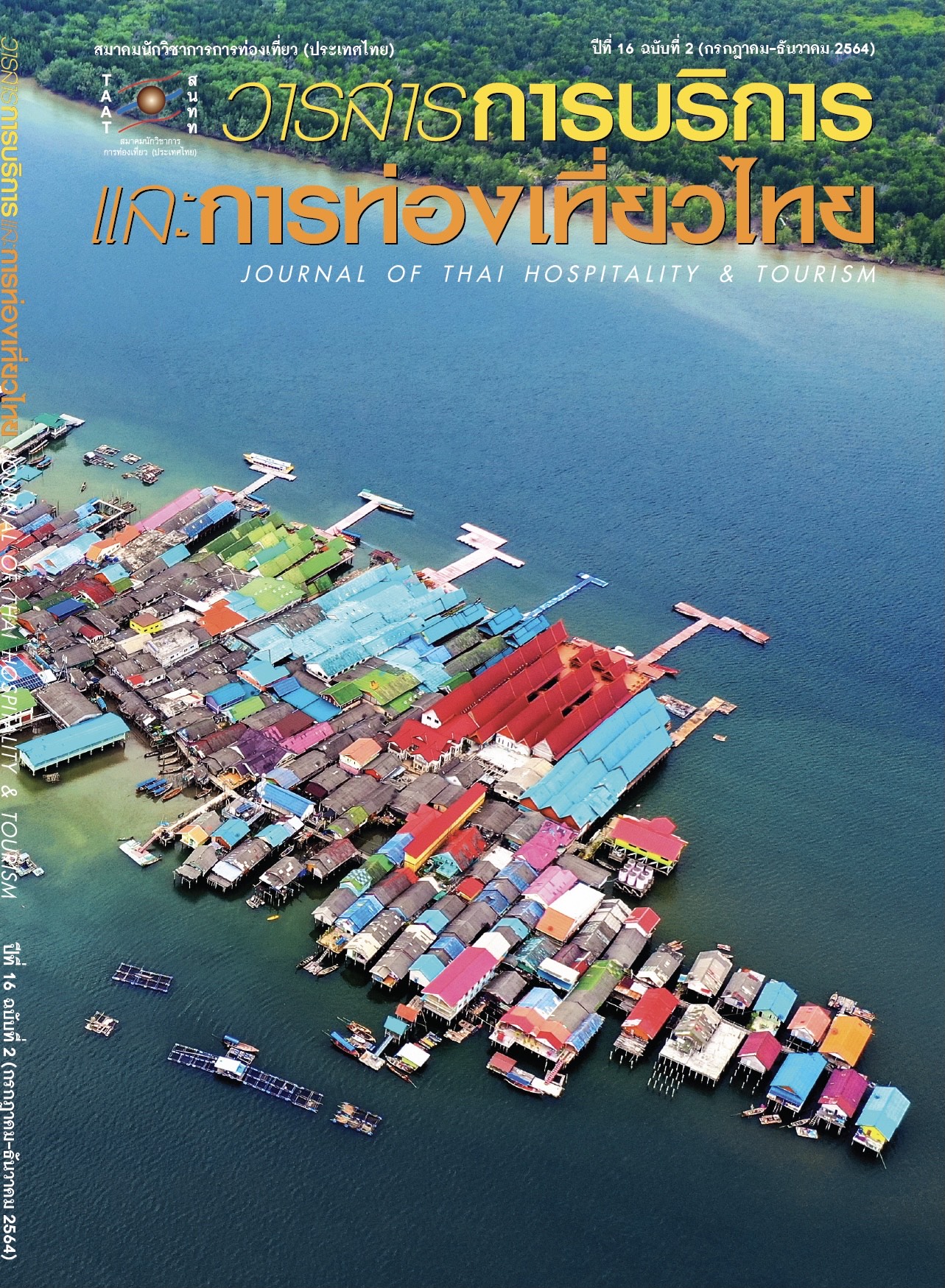แนวโน้มพฤติกรรมการท่องเที่ยวของนักศึกษามหาวิทยาลัยในอาเซียน: การประยุกต์ใช้ทฤษฎีพฤติกรรมตามแผน
Main Article Content
บทคัดย่อ
งานวิจัยเรื่องนี้ได้นำทฤษฎีพฤติกรรมตามแผนมาประยุกต์ใช้เพื่อศึกษาปัจจัยที่ส่งผลต่อแนวโน้มเชิงพฤติกรรมการท่องเที่ยวของกลุ่มนักศึกษามหาวิทยาลัยในการเดินทางท่องเที่ยวภายในกลุ่มประเทศอาเซียนภายหลัง AEC โดยได้เพิ่มตัวแปรด้านแรงจูงใจในการท่องเที่ยวในทฤษฎีต้นแบบ การวิจัยเชิงปริมาณครั้งนี้ใช้แบบสอบถามเป็นเครื่องมือในการศึกษา โดยแบบสอบถามจำนวน 620 ชุด ได้ถูกแจกจ่ายไปยังนักศึกษามหาวิทยาลัยในประเทศไทยและประเทศมาเลเซีย ทั้งนี้ข้อมูลดิบที่สามารถนำไปใช้ในการวิเคราะห์ข้อมูลได้มีจำนวนทั้งสิ้น 583 ชุด การวิเคราะห์การถดถอยแบบพหุคูณได้ถูกใช้เพื่อศึกษาปัจจัยที่มีอิทธิพลต่อแนวโน้มพฤติกรรมการท่องเที่ยว ณ ประเทศกลุ่มอาเซียนของนักศึกษามหาวิทยาลัยในอาเซียนในครั้งนี้ ผลการศึกษาพบว่า ปัจจัยหลักของทฤษฎีดังกล่าวคือ ทัศนคติต่อการท่องเที่ยวในกลุ่มประเทศอาเซียน กลุ่มอ้างอิงที่มีอิทธิพลต่อการท่องเที่ยวในกลุ่มประเทศอาเซียน และการรับรู้เกี่ยวกับอุปสรรคในการท่องเที่ยวมีอิทธิพลต่อแนวโน้มพฤติกรรมการท่องเที่ยวภายในภูมิภาคของนักศึกษามหาวิทยาลัยในอาเซียนอย่างมีนัยสำคัญทางสถิติ อีกทั้งผลการวิเคราะห์สมการถดถอยพบว่า แรงจูงใจในการท่องเที่ยว โดยเฉพาะเพื่อหาความรู้เกี่ยวกับแหล่งงานในอนาคตเป็นปัจจัยที่มีอิทธิพลต่อแนวโน้มด้านการท่องเที่ยวของนักท่องเที่ยวเยาวชนกลุ่มนี้ ผลการศึกษาเรื่องนี้เป็นประโยชน์ต่อทั้งเชิงวิชาการในศาสตร์ที่เกี่ยวข้องกับการท่องเที่ยวและการบริการรวมถึงหน่วยงาน และอุตสาหกรรมที่เกี่ยวข้องกับนักท่องเที่ยวกลุ่มนี้ อีกทั้งหน่วยงานที่เกี่ยวข้องกับแรงงานและสวัสดิการสังคม ก็ควรมีการเตรียมความพร้อมในการรองรับแรงงานฝีมือที่มีความสนใจที่จะทำงานในประเทศอาเซียนอีกด้วย
Article Details
เอกสารอ้างอิง
Ajzen, I. (1991). The Theory of Planned Behavior. Organizational Behavior and Human Decision Processes, 50(2), 179–211.
Crompton, J. L. (1979). Motivations for Pleasure Vacation. Annals of Tourism Research, 6(4), 408–424.
Field, A. P. (2009). Discovering Statistics Using SPSS. London: Sage Publications.
Hair, J. F., Black, W. C., Babin, B. J. & Anderson, R. E. (2010). Multivariate Data Analysis: A Global Perspective. Upper Saddle River, N. J.: Pearson.
Hsu, C. H. C. & Huang, S. (2010). An Extension of the Theory of Planned Behaviour Model for Tourists. Journal of Hospitality and Tourism Research, 12(21), 1–28.
Hsu, C. H. C. & Lam, T. (2004). Theory of Planned Behaviour: Potential Travelers from China. Journal of Hospitality and Tourism Research, 28(4), 463–482.
Hsu, C. W. (2011). Motivations of People who Visit Disneyland. Retrieved from http://griffith.summon.serialssolutions.com
Kim, K., Oh, I. K. & Jogaratnam, G. (2007). College Studen Travel: A Revised Model of Push Motives. Journal of Vacation Marketing, 13(1), 73–85.
Lam, T. & Hsu, C. H. C. (2006). Predicting Behavioural Intention of Choosing a Travel Destination. Tourism Management, 27(4), 589–599.
Madden, T. J., Ellen, P. S. & Ajzen, I. (1992). A Comparison of the Theory of Planned Behavior and the Theory of Reasoned Action. Personality and Social Psychology Bulletin, 18, 3–9.
Misung, L., Heesup, H. & Tim, L. (2012). Medical Tourism – Attracting Japanese Tourists for Medical Tourism Experience. Journal of Travel and Tourism Marketing, 29(1), 69–86.
Phillips, W. J. & Jang, S. (2012). Exploring Seniors’ Casino Gaming Intention. Journal of Hospitality and Tourism Research, 36(3), 312–334.
Ryan, C. & Zhang, Z. (2007). Chinese Students: Holiday Behaviours in New Zealand. Journal of Vacation Marketing, 13(2), 91–105.
Sparks, B. & Pan, G. W. (2009). Chinese Outbound Tourists: Understanding their Attitudes, Constraints, and Use of Information Sources. Tourism Management, 30(4), 483–494.
Sparks, B. (2007). Planning a Wine Tourism Vacation: Factors that Help to Predict Tourist Behavioural Intentions. Tourism Management, 28(5), 1180–1192.
Story, M. A. (2011). Travel Motivations of African–Americans Age 21 to 31. Retrieved from http://griffith.summon.serialssolutions.com
World Tourism Organization. (2016). UNWTO Tourism Highlights 2016. Retrieved from http://mkt.unwto.org


